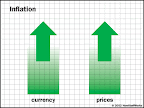
If is an earthquake in a particular region, then all individual in that region will get affected by the earthquake in some way or the other. No one will be able to escape it, whether he is male or female, rich or poor, child or old. This is because the impact of earthquake is in the system. Some other examples of risks that exist in the system are political situations, war etc. Similarly since inflation exists in the system, everyone will be affected in some way or the other and there is no way one can avoid inflation. Economic meaning of inflation is �general and progressive rise in prices.� However more apt explanation for inflation would be to state that it is a phenomenon which exists in the system and slowly affects all parameters of finance. We can say it is a silent killer. Further since inflation exists in the system there is no way to escape it.
Secondly, inflation is always prevalent in the system and therefore it continuously affects us. Sometimes the impact of inflation is high and sometimes it is less. However it is never absent unless economy is contracting. Cost of a masala dosa in 1987 was Rs 3.50. Same masala dosa in 1997 costed Rs 14.00. If the rise in prices continues at same rate then in year 2017 masala dosa will cost Rs 224.00. Similarly cost of Colgate toothpaste in 1987 was Rs 8.05. It increased to Rs 18.90 in 1997. If it keeps progressing at same rate in 2017 we will have to pay Rs 104.00. All of us witnessed the rise in prices of masala dosa and Colgate toothpaste. However since it was slow we did not realize how large its impact is in the long run.
There are four pillars of finance (i) Assets (investments) (ii) Liabilities (Borrowings) (iii) Income (iv) Expenses.
Since inflation exists in the system, it affects all our investments. Assume we are generating 8%, 20%, 12% and 25% returns from debt, equity, gold and real estate respectively. If rate of inflation in the system is 11% than our real rate of return from debt will be 8% - 11% = -3%, equity returns will be 20%-11%%=9%, Gold returns will be 12%-11%=1% and real rate of return from real estate will be 25%-11%=14%. Thus inflation affects all our investments.
During inflation, rate of interest in the economy rises. Therefore invariably our rate of interest on borrowing will rise. We will have to pay higher rate of interest on our borrowings. Cost of home loan, car loan etc. will go up. As far as possible avoid borrowings and if there is loan, get out of it as soon as possible.
Since value of rupee depreciates due to inflation, our income can buy lesser goods and services. Thus inflation indirectly reduces value of our earning.
Lastly inflation has direct impact on expenses. Since inflation increase general rate of prices, all goods and services become expensive.
While we cannot escape inflation we can try and reduce its impact on us. From investment perspective we should invest in assets which can generate returns higher than rate of inflation. These are equity, Gold and real estate. However these asset classes are highly volatile in near term.
Sure shot way to beat inflation, is to increase our level of income. However it is not possible for individuals to increase level income immediately. Therefore during higher inflation period if possible find out avenues to increase income level. This is easier said then done.
Learn to control your expenses..
Expenses are something that can be tackled. Before discussing strategies to control expense first let us try and understand categories of expenses. Broadly there are two categories of expenses (i) Mandatory (ii) Voluntary. Within each of these categories there are fixed and variable expenses e.g. Mandatory fixed expenses e.g. school fees, house rent etc. Next these are Mandatory variable expenses like grocery, medical and health care expense etc. There is absolutely no one way can avoid mandatory expenses.
In case of voluntary expenses again there are two categories e.g. Voluntary fixed expenses e.g. Gymnasium fees, club membership etc. Voluntary variable expenses include eating out, vacations etc. While the inflation is rising we should cut down on voluntary variable expenses at once. Also as and when renewal for voluntary fixed expenses come up same can be reduced or stopped completely.
Even after controlling voluntary expenses if we are struggling to make two ends meet, then we should follow step down process. Let us consider example of cost of transport to work, a mandatory variable expense. Using a chauffer driven car is the upper most step and walking is lower most step. After deciding on these two find our other options by lowering one step. After chauffer driven car next lower step could be to self drive car to work. Step lower than that could be car pool and step lower than car pool could be to use public transport. Once the ladder is constructed we should find out optimal suited option.
Invariably we focus too much on risks which are transparent like volatility of equity market, illness in family etc. Unfortunately a non-transparent risk like inflation gets ignored. However, just because we cannot see impact of inflation on our finances, it does not mean inflation does not exist. Inflation is a silent killer and if we ignore it, one day it will kill us.





















